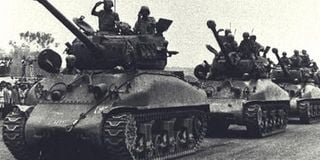War in Uganda: Coverage of the 1979 liberation war

What you need to know:
- The downside of this book is that it’s told from the perspective of the Tanzanian side alone. Also, the authors’ account is based on the central axis where they were based.
- The more than 200 page Tanzania Publishing House book hit the shelves of bookstores in 1983, four years after the war.
War in Uganda: The legacy of Idi Amin is probably the only book yet to have graced the bookstores about the 1979 war that toppled former president Idi Amin.
The book was written by American journalists Tony Avirgan and Martha Honey, then based in Tanzania, who were given a rare opportunity to follow in the tracks of the advancing Tanzania People’s Defence Forces as they marched to capture Kampala and topple former president Idi Amin in April 1979.
The book is an account of two foreigners who found themselves in a position to record both military and political changes in Uganda as the war progressed. It is a unique war reportage and analysis of social and political forces that characterised the war and the immediate aftermath of the fall of Amin.
The authors explain the secrecy first employed by the Tanzanian government at the start of the war as they pushed the invading Ugandan army out of Tanzania. It was not until then Tanzanian president Julius Nyerere decided that his troops should match to Kampala that it was made official that his troops were on Ugandan soil.
The 11-chapter book starts with a background of how Amin managed to stay in power for the eight years and how each passing day made his cling onto power fragile.
The authors also take the reader through the central and western axis used in the war against Amin. They also give a glimpse of what happened in the Moshi Conference which formed the post-Amin government.
Avirgan and Honey were embedded in the battalion that captured Entebbe and Kampala and they give a graphic account of the battle for the two places. The authors go a step further into the politics of the post-Amin regime and situation in Uganda soon after the war.
Despite the quality, the authors provide some pictorial evidence of the effects of war in Masaka, Kagera in Tanzania and of some of the Libyans captured in the battlefield.
Having witnessed the fall of Kampala, they were also witnesses to the looting that followed the fall. They describe the celebratory mood on the streets of Kampala the day Yusuf Lule was sworn in as president.
The downside of this book is that it’s told from the perspective of the Tanzanian side alone. Also, the authors’ account is based on the central axis where they were based. For the western axis under the command of Col Mayunga, they based on recollections of fighters and locals.
Despite being a one-sided narrative, the book takes the readers into the battlefield and the immediate aftermath of the fall of Kampala.
The more than 200 page Tanzania Publishing House book hit the shelves of bookstores in 1983, four years after the war.
Unfortunately, the book is currently out of print. What can be found are second hand copies online.




